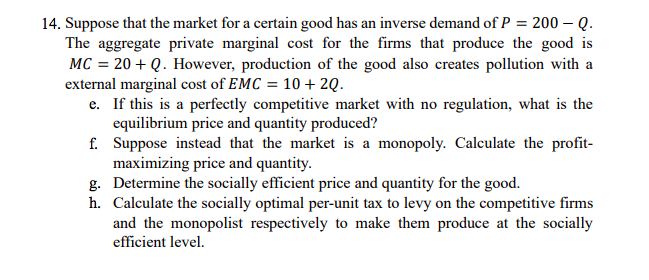14. Suppose that the market for a certain good has an inverse demand of P = 200 – Q. The aggregate private marginal cost for the firms that produce the good is MC = 20 + Q. However, production of the good also creates pollution with a external marginal cost of EMC = 10 + 2Q. e. If this is a perfectly competitive market with no regulation, what is the equilibrium price and quantity produced? f. Suppose instead that the market is a monopoly. Calculate the profit- maximizing price and quantity. g. Determine the socially efficient price and quantity for the good. h. Calculate the socially optimal per-unit tax to levy on the competitive firms and the monopolist respectively to make them produce at the socially efficient level.
14. Suppose that the market for a certain good has an inverse demand of P = 200 – Q. The aggregate private marginal cost for the firms that produce the good is MC = 20 + Q. However, production of the good also creates pollution with a external marginal cost of EMC = 10 + 2Q. e. If this is a perfectly competitive market with no regulation, what is the equilibrium price and quantity produced? f. Suppose instead that the market is a monopoly. Calculate the profit- maximizing price and quantity. g. Determine the socially efficient price and quantity for the good. h. Calculate the socially optimal per-unit tax to levy on the competitive firms and the monopolist respectively to make them produce at the socially efficient level.
Principles of Microeconomics
7th Edition
ISBN:9781305156050
Author:N. Gregory Mankiw
Publisher:N. Gregory Mankiw
Chapter10: Externalities
Section: Chapter Questions
Problem 8PA
Related questions
Question

Transcribed Image Text:14. Suppose that the market for a certain good has an inverse demand of P = 200 – Q.
The aggregate private marginal cost for the firms that produce the good is
MC = 20 + Q. However, production of the good also creates pollution with a
external marginal cost of EMC = 10 + 2Q.
e. If this is a perfectly competitive market with no regulation, what is the
equilibrium price and quantity produced?
f. Suppose instead that the market is a monopoly. Calculate the profit-
maximizing price and quantity.
g. Determine the socially efficient price and quantity for the good.
h. Calculate the socially optimal per-unit tax to levy on the competitive firms
and the monopolist respectively to make them produce at the socially
efficient level.
Expert Solution
This question has been solved!
Explore an expertly crafted, step-by-step solution for a thorough understanding of key concepts.
Step by step
Solved in 3 steps with 3 images

Knowledge Booster
Learn more about
Need a deep-dive on the concept behind this application? Look no further. Learn more about this topic, economics and related others by exploring similar questions and additional content below.Recommended textbooks for you

Principles of Microeconomics
Economics
ISBN:
9781305156050
Author:
N. Gregory Mankiw
Publisher:
Cengage Learning

Principles of Economics, 7th Edition (MindTap Cou…
Economics
ISBN:
9781285165875
Author:
N. Gregory Mankiw
Publisher:
Cengage Learning

Principles of Economics (MindTap Course List)
Economics
ISBN:
9781305585126
Author:
N. Gregory Mankiw
Publisher:
Cengage Learning

Principles of Microeconomics
Economics
ISBN:
9781305156050
Author:
N. Gregory Mankiw
Publisher:
Cengage Learning

Principles of Economics, 7th Edition (MindTap Cou…
Economics
ISBN:
9781285165875
Author:
N. Gregory Mankiw
Publisher:
Cengage Learning

Principles of Economics (MindTap Course List)
Economics
ISBN:
9781305585126
Author:
N. Gregory Mankiw
Publisher:
Cengage Learning

Essentials of Economics (MindTap Course List)
Economics
ISBN:
9781337091992
Author:
N. Gregory Mankiw
Publisher:
Cengage Learning

Principles of Microeconomics (MindTap Course List)
Economics
ISBN:
9781305971493
Author:
N. Gregory Mankiw
Publisher:
Cengage Learning
